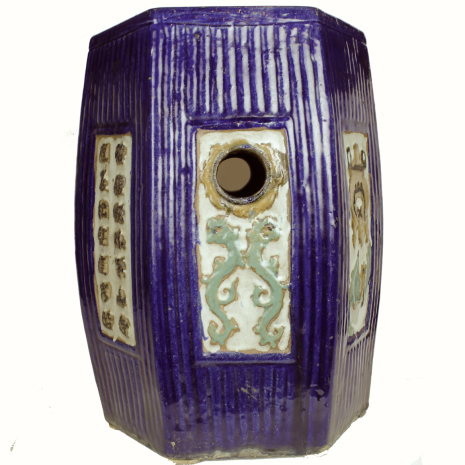Description
This stoneware glazed garden stool was used by a wealthy family reflected in its complex designs, auspicious symbols and its use of so much cobalt blue, a highly prized and expensive mineral paint color normally used sparingly. The pierced side to side circles running through the inside from side to side and the pierced design on the top of the tool are not only decorative, they also make stools less likely to have firing defects caused by excess heat inside the kilns. Cutouts and other openings also seats more comfortable in the summer enabling them cool naturally and at a quicker rate. The coin cutout on the top with a wan design allows water to drain naturally and prevents pooling on the top and why stool tops are made slightly convex instead of flat. Coins are a wish for wealth and a wan design inside the coin is a symbol meaning “countless” or “unlimited,” that, with the coin, is a wish for extensive wealth. All side panels are decorated with popular icons. The dragon represents the emperor and is a wish for high rank and power and a symbol of fertility as dragons bring rain to China to fertilize crops. They are paired in two panels here chasing a flaming pearl said to be a symbol of the sun, a wish-granting jewel, transcendent wisdom or enlightenment. As the word for vase (ping) sounds much like the Chinese word for peace (ping’an), this vase panel is a wish for peace and explains why vases are found in most Chinese homes. A fourth panel contains a bat and an incense burner. Bats symbolizing fu is a symbol for everything that is auspicious as it is a homophone for “fu” that translates to “happiness” or “blessings,” as it sounds like bat (fu). The incense burner complements the bat, as incense offerings are made to deities and one’s ancestors who aid in fulfilling one’s auspicious wishes, also fu. The last two panels have calligraphy of a very famous 8th-century poem called “Night Mooring at Maple Bridge” by Zhang Ji (also Chang Chi, circa 730-780 CE) which has been translated as follows:
“While I watch the moon go down, a crow caws through the frost;
Under the shadows of maple-trees a fisherman moves with his torch;
And I hear, from beyond Su-chou, from the temple on Cold Mountain,
Ringing for me, here in my boat, the midnight bell.”
For a more contemporary design context, sturdy stoneware stools allow one to easily and inexpensively convert them into unique and attractive low tables with the addition of a glass or sturdy wood grained top.
Sources
Terese Tse Bartholomew, Hidden Meanings in Chinese Art, San Francisco, the Asian Art Museum, 2006.
Nancy Berliner, Beyond the Screen: Chinese Furniture of the 16th and 17th Centuries, Boston, Museum of Fine Arts, 1996.
Nancy Berliner and Sarah Handler, Friends of the House: Furniture from China’s Towns and Villages, Salem, Peabody Essex Museum, 1995.
Sarah Handler, Austere Luminosity of Chinese Furniture, Berkeley, University of California Press, 2001.
William Lipton, The Wondrous and Amenable Chinese Stool, New York, Red Leaf Press, 2000.
Patricia Bjaaland Welch, Chinese Art: A Guide to Motifs and Visual Imagery, Rutland, Tuttle Publishing, 2008.
Click here for the blog The Ubiquitous and Charming Chinese Ceramic Stool.
Additional information
| Place of Origin | China |
|---|---|
| Period | Antique, Qing Dynasty |
| Date | 19th Century |
| Materials and Technique | Stoneware |
| Dimensions (inches) | Ht: 18.25” W: 12” D: 11.25” |
| Dimensions (metric) | Ht: 46.35cm W: 30.48cm D: 28.57cm |
| Weight | 29lbs 7oz |
| Item Number | 16779ZLSE |
| Condition | Excellent, age appropriate signs of wear |
| Width | 12” to 17.9” |
| Shipping Box Size | Oversized. Call 213-568-3030 or email [email protected] for shipping. |


















